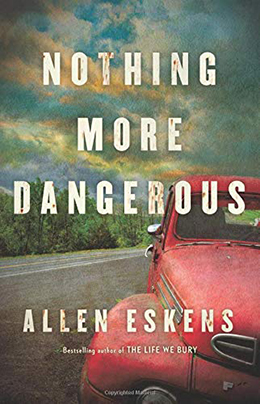“…sometimes when you look down at the surface of a pond, all you can see is your own reflection, not the depth of what’s on the other side.”
– Hoke Gardner, Nothing More Dangerous
The diversity movement in crime fiction over the last year has largely focused on #OwnVoices which makes sense since the community is justifiably wanting – demanding – to hear from the under-represented minorities in our midst, but it can be just as important to recognize the contributions from the current crop of published authors who strive to be more inclusive in their own narratives. Nothing More Dangerous, the new stand-alone from Allen Eskens is a fine example, one in which the author uses his vantage point as a straight, white man to illustrate how a young, white boy in the south must navigate what he has been taught about people who are different from himself (in terms of race, class, sexual orientation, et al.) and reconcile that with what he himself observes within the real world. Needless to say, this young boy is in for a rude awakening, but Allen Eskens presents it in a way that feels authentic to this boy’s story without minimizing the truths of those groups this boy previously misunderstood.
It is 1976 and the boy at the heart of Nothing More Dangerous is Boady Sanden, a fifteen-year-old living in Jessup, Missouri and attending his first semester at St. Ignatius High School. Boady’s dad has died and Boady’s mom works at the local factory, where Boady also picks up a few hours of labor after school in an effort to save enough money to escape this small town as soon as possible. But when the large, long-vacant, house on his street finally gets new residents, Boady’s life is turned upside-down. The affluent, African-American Elgin family is relocating to Jessup because Charles Elgin – the patriarch – has been hired as the new foreman at the Ryke factory. Along with his wife, Charles brings along his son Thomas, who is about the same age as Boady. Although their first meetings are tense and the two boys struggle to relate to each other, both Boady and Thomas forge ahead with friendship despite the distrust of many of the town’s citizens.

Like many Midwestern/Southern small towns in the 1970’s (hell, even today), this town of Jessup has a large population that aspires to white supremacy. Allen Eskens creates a group called the CORPS – Crusaders of Racial Purity and Strength – that works around the fringes of society to make sure their ignorant views are acted upon in an effort to maintain the control they have wielded for generations. Those beliefs are about to come into direct contradiction to the truth that Boady begins to understand – things he learns as he gets to know his neighbors, both old and new; his family and few friends; and most importantly himself.
Nothing More Dangerous is many things, but at the core it is a coming-of-age story about a boy who refuses to settle for the status quo when he realizes that inequality has existed for far too long. Woven around that are several extremely well-developed mysteries: what happened to Hoke Gardner that left him scarred both physically and mentally; what is Hoke Gardner documenting in all those journals he writes in everyday; why did Lida Poe, the African-American bookkeeper run off with thousands of dollars; why has Boady’s mother turned inward when faced with widowhood; whose body was discovered near the CORPS meeting hall, and more importantly, who is responsible for that murder? Allen Eskens addresses all of this in beautifully-crafted prose that unspools like the finest gossamer weaving webs of secrets, deceit, hate, and retribution alongside unforgettable moments of tenderness, understanding, and acceptance. The multiple mysteries within the text bring Boady and Thomas closer, turning them into a pair of mixed race Hardy Boys, intent on finding the answers even as they place themselves at greater and greater risk.
Nothing More Dangerous is told in hindsight, so readers are presented with Boady’s recollections of that summer. Fans of Allen Eskens may remember that Boady Sanden appears in a more minor capacity in some of Eskens’ earlier novels. It is nice to see how this future attorney came by his moral compass. In a forward to this novel, Allen Eskens tells readers that he has struggled to write it for decades and it is clear that this was a author who was aware of the potential risks in telling such a story, but who also recognized the value in its being told – and told correctly. There were many places within Nothing More Dangerous where things could have gotten derailed, but thankfully they never do. Mr. Eskens should be commended for taking this chance and for allows both his characters and the reader to dawn their own conclusions organically without any type of forced judgment. Well done indeed!
BUY LINKS: Nothing More Dangerous by Allen Eskens
______________________________________________________________________
Disclaimer: A egalley of this title was provided to BOLO Books by the publisher. No review was promised and the above is an unbiased review of the novel.
